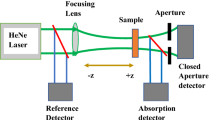Abstract
In the case of cw Gaussian illumination, the thermo-optical n2 cannot be characterised by a constant value. It is shown that, if absorption has both linear and nonlinear contributions, the thermo-optical n2 consists of a position- and power-dependent term. Hence analytical formulae that assume a constant n2 are no longer valid for the Z-scan fitting. In this paper a new Z-scan theory is introduced, which is applicable to the thermo-optical effect in the presence of both linear and nonlinear absorption and an arbitrary extent of optical nonlinearity. The calculation technique can be used for large sample thickness too, by dividing it into thin slices. It was found that inside one slice, the distribution of the light-induced refraction is similar to that for the case of graded index media. The propagation can be described through the transformation of the q-parameter. It is demonstrated that the Z-scan technique makes the sensitive measurement of the linear absorption coefficient possible. The linear and nonlinear absorption coefficients were experimentally determined for Mg doped LiNbO3 to be α=0.6 m-1 and β=2.9×10-9 m/W, respectively.
Similar content being viewed by others
References
M. Sheik-Bahae, A.A. Said, T.H. Wei, D.J. Hagan, E.W. Van Stryland: IEEE J. Quantum Electron. 26, 760 (1990)
J.A. Hermann, R.G. McDuff: J. Opt. Soc. Am. B 10, 2056 (1993)
C.H. Kwak, Y.L. Lee, S.G. Kym: J. Opt. Soc. Am. B 16, 600 (1999)
P.P. Banerjee, R.M. Mirsa, M. Maghraoui: J. Opt. Soc. Am. B 8, 1072 (1991)
G. Tsigaridas, M. Fakis, I. Polyzos, P. Persephonis, V. Giannetas: Appl. Phys. B 76, 83 (2003)
M. Sheik-Bahae, A.A. Said, D.J. Hagan, M.J. Solileasu, E.W. Van Stryland: Opt. Eng. 30, 1228 (1991)
H. Li, F. Zhou, X. Zhang, W. Ji: Appl. Phys. B 64, 659 (1997)
J.T. Verdeyen: Laser Electronics (Prentice Hall, NJ 1995)
J.P. Gordon, R.C.C. Leite, R.S. Moore, S.P. Porto, J.R. Whinnery:J. Appl. Phys. 36, 3 (1965)
L. Pálfalvi, J. Hebling, G. Almási, Á. Péter, K. Polgár: J. Opt. A: Pure Appl. Opt. 5, S280 (2003)
L. Pálfalvi, G. Almási, J. Hebling, Á. Péter, K. Polgár: Appl. Phys. Lett. 80, 2245 (2002)
SNLO nonlinear optics code available from A.V. Smith, Sandia National Laboratories, Albuquerque, NM 87185-1423
U. Schlarb, K. Betzler: Phys. Rev. B 48, 15613 (1993)
Author information
Authors and Affiliations
Corresponding author
Additional information
PACS
42.79.Ry; 78.20.Nv; 77.84.Dy
Rights and permissions
About this article
Cite this article
Pálfalvi, L., Hebling, J. Z-scan study of the thermo-optical effect. Appl. Phys. B 78, 775–780 (2004). https://doi.org/10.1007/s00340-004-1501-y
Received:
Revised:
Published:
Issue Date:
DOI: https://doi.org/10.1007/s00340-004-1501-y



